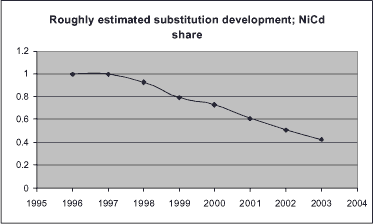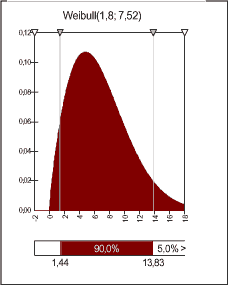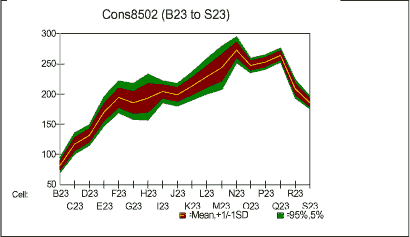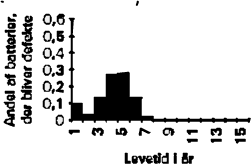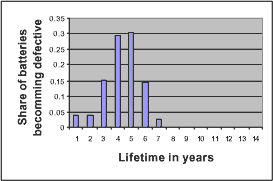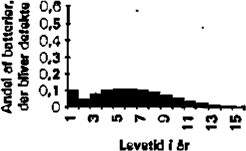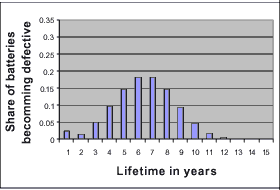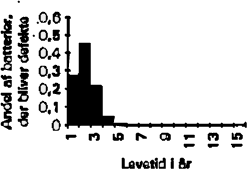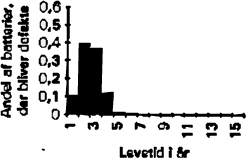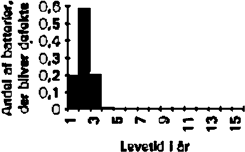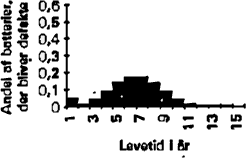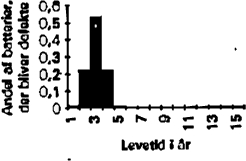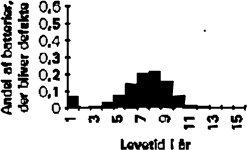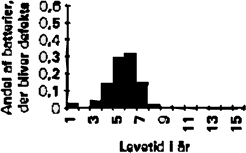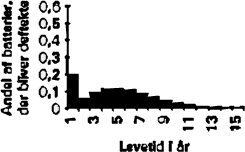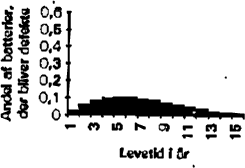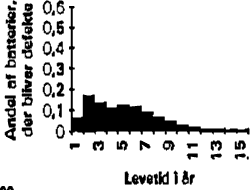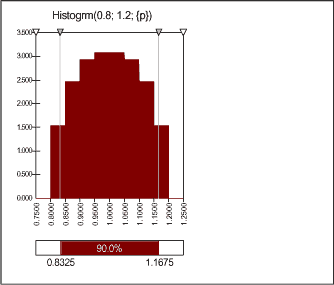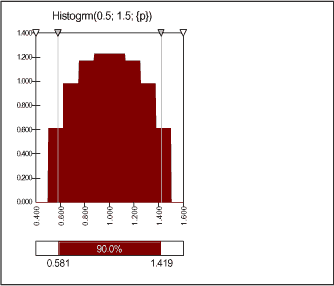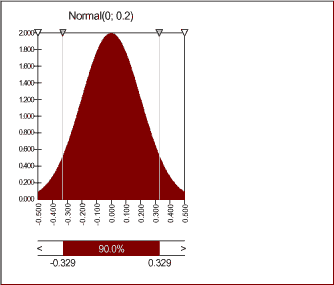|
Environmental Project no. 1004, 2005 Collection Potential for Nickel-Cadmium Batteries in DenmarkTable of Content2 NiCd battery use and consumption
3 Assessment of the collection potential
Appendix A Battery lifetime data and distributions used Appendix B Uncertainty distributions used PrefaceSince the beginning of the 1990's Denmark has carried out separate collection of nickel cadmium batteries in the waste stream. The collection potential for nickel cadmium batteries is a very important parameter in assessing the success of the separate collection of nickel cadmium batteries and the Danish Environmental Protection Agency has therefore chosen to carry out an update of the earlier collection potentials assessed in 1994 [Maag and Hansen, 1994]. The update will make it possible to get a more realistic picture of the current and future efficiency of NiCd-batteries collection in Denmark. The need for an update of the collection potential is primarily caused by changes in the consumption pattern for NiCd battery use, especially due to the gradual substitution with Nickel metal hydride and Lithium-ion batteries, for many applications. The report has been financed by the Danish Environmental Protection Agency and its preparation been supervised by a steering committee consisting of: Anne Nielsen, Danish EPA (Chair) Frederik Madsen, Association of Danish Manufaturers and Importers of Dry Batteries Jakob Maag, COWI A/S This assessment was prepared by: Jakob Maag, COWI A/S Charlotte Libak Hansen, COWI A/S SummaryOnly half of spent cadmium batteries are collected separatelyThe collection potential for nickel-cadmium (NiCd) batteries, e.i. the amounts of NiCd batteries that are disposed of annually in Danish society, have been assessed at about the double of the NiCd battery amounts actually collected through the Danish separate NiCd waste collection scheme. Cadmium is a toxic heavy metal. To minimize cadmium pollution, Denmark has worked for more than two decades to minimize the inputs of cadmium to society. NiCd batteries are today by far the main contributor of cadmium inputs to Danish society. The results indicate that while much is being done to collect NiCd batteries, substantial NiCd amounts may still be disposed of with ordinary waste, resulting in increased cadmium pollution now and in the future. The estimation method, developed for the Danish EPA, seem quite robust to uncertainties associated with input numbers. The assessment is an update of a similar study from 1994. Background and scopeThe aim of this assessment is to estimate the collection potential of NiCd batteries, i.e. the total quantity of NiCd batteries that could be collected in a given year, if the users dispose of all NiCd batteries through proper collection schemes, and do not discard them with household waste etc. This assessment is a 2004 update for Denmark, based on the methodology developed by Maag and Hansen (1994) in their first assessment of the collection potential for rechargeable batteries. The update was prepared for the Danish EPA. The AssessmentThe collection potential is here attempted estimated on the basis of the following factors:
Main resultsThe collection potentials for NiCd batteries in Denmark in 1997-2004 were assessed to fall between the min and max values shown in table 0-1. The estimated collection potentials proved to be quite stable towards the applied hoarding effect scenarios. For the years 1997-2002 the estimated collection potentials have been compared to the amounts of NiCd batteries which have actually been collected in Danish scheme for the separate collection of NiCd batteries. Estimated collection efficiency varies over the years but generally lies within about 30-70% of the estimated collection potentials. Table 0-1 mean collection potential values, as well as the minimum and maximum considered plausible, across all 4 scenarios, in tonnes/y.
Note *1: Minimum and maximum among all quantiles across all four hoarding scenarios and all three lifetime options tested. *2: An alternative presentation of the uncertainty on the mean, e.i. the distance between the mean value and the interval limits. The numbers in the column express the "A" in the often used notation "Mean +/- A %". Project resultsSealed nickel-cadmium batteriesThis report covers sealed nickel-cadmium accumulators, also called NiCd rechargeable batteries. They are commonly referred to as NiCd-batteries and that is the designation used in this report. Large box-type so-called "open" NiCd accumulators (with an appearance similar to lead starting batteries for vehicles etc.) are not covered in this report. Open NiCd accumulators are not very much used in Denmark (Drivsholm et al., 2000), and are not collected through the same channels as NiCd-batteries in Denmark. Illustration of how consumption, lifetime and hoarding effect scenarios affect the collection potentialThe relationship between consumption, battery defect rate and collection after the hoarding effect is shown for an example, professional power tools, in figure 3-2 below. It should be noted that the figure is only meant to illustrate the principles applied in the assessment, and discussion of the numbers themselves are given in other sections of the report. The blue line is the estimated consumption of NiCd batteries in the assessed period. The consumption peaked in 1988 and 2000. The consumption before 1985 and after 2004 was not estimated. As such, the figure illustrates in principle how the situation would be if sales of this NiCd application did not continue after 2004. The pink line illustrates how the defect rates are delayed compared to the consumption. The peak defect rates are observed after about 1 mean lifetime after the consumption peaks. The defect rate peaks are wider than the consumption peaks because the lifetime distribution applied spreads the battery defect incidents over a range of years around the average lifetime, reflecting the fact that not all batteries becomes defective at exactly the same time after purchase. The defect rates before 1990 are not shown, because the input consumption estimates before 1985 are not available. The yellow line is the calculated annual collection potentials. It illustrates how the hoarding effect further delays the actual discarding of the defective batteries. In this case, the collection potential under hoarding effect scenario 3 is shown (see section 3.6). In this scenario, half of the consumption of professional power tools is assumed used by so-called "organised users", who discard their defective batteries 1 year after defect on average, while the other half is assumed used by "un-organised users", who discard their defective batteries 7 years after defect on average. The discarding time is delayed in time compared to the time where the battery becomes defective, and the compound hoarding effect model used in scenario 3 further spreads the discarding of the consumed batteries over time. If a uniform delay in time for all applications (scenario 4) had been shown, the yellow line would be a precise replica of the defect rate line (pink line), but would simply be delayed 4 years, compared to the defect rates. Consumption estimatesA detailed overview of the consumption of NiCd batter over time and distributed on uses is given in table 2.8 in section 2.9.1. The same data are shown in figure 0.2 below. For the background of the individual data, please see the respective sections of the report. Note that the category "other uses" reflects rough estimates for the period 1985-1993, as derived by Maag and Hansen (1994), interpolations for the period 1994-1996, and balances versus tax-derived NiCd consumption totals for the years 1997-2002, as described in section 2.9.2 The figure shows how consumption peaked around 1997-2000, and declined through 2002 as NiCd batteries were gradually substituted for by NiMH and Li-ion batteries. Only few uses remain, cordless power tools being the most important tonnage wise. Also for power tools however, substitution has set in over the last few years. Assessment resultsThe assessment results are presented in detail in table 3.8 in section 3.8. A close look at table 3.8 reveals that the resulting collection potentials are rather robust to both the hoarding effect scenarios, and the different lifetime options tested, for the period 1997-2005, which is of most interest here. This is considered mainly a result of the consumption trends in the years influencing the values most, in combination with the "smoothing" effect of the battery lifetime distributions (not all batteries bought in "year 1" become defective within the same "year x", see illustration above). As shown in section 2.9, the consumption peaked in the years 1997-2000 and exhibits a declining trend from 2000 to 2002. Table 0.2 below show the estimated mean collection potential values, as well as the absolute minimum and maximum among the presented quantiles, across all 4 scenarios. The table also show the calculated differences between minimum and maximum quantiles for each year in tonnes, and half of the same difference in percent of the mean value. Table 0-2 mean collection potential values, as well as the minimum and maximum considered plausible, across all 4 scenarios, in tonnes/y.
Note *1: Minimum and maximum among all quantiles across all four hoarding scenarios and all three lifetime options tested. *2: An alternative presentation of the uncertainty on the mean, e.i. the distance between the mean value and the interval limits. The numbers in the column express the "A" in the often used notation "Mean +/- A %". ConclusionsThough the assessment made do not fully include all associated uncertainties, it may be concluded that there is a high likelihood that the true collection potentials for NiCd batteries in Denmark fall between the min and max values shown in table 0.2. For comparison, the collected amounts of NiCd batteries in Denmark each year since the introduction of the state-paid awards for collected NiCd's in 1996 are shown in table 0.3. Table 0-3 Collected NiCd batteries registered in Denmark 1996-2003, tonnes/y (Danish EPA, 2004)
Note that some time passes between the NiCd batteries are originally collected and the time when the awards are paid and the amount therefore can be seen in the Danish EPA's statistics (so-called "pipeline effect"). In line with normal business principles, this time does most likely not exceed 1 year. The collection award was 120 DKK/kg NiCd batteries collected from 1996-1999, but was raised to 150 DKK/kg as from 2000. The award is the main driver behind this controlled system, and the numbers presented may be considered as precise. When comparing the data in the two tables, the overview shown in table 0.4 emerge. Note that here, the collected amounts presented for 1997 are the amounts registered in 1998, to account for the pipeline effect. The table shows that the estimated collection potentials indicate that large amounts of NICd batteries have been collected, but a more or less equal part of the potential has not been collected. Table 0-4 Comparison between estimated collection potentials and actually collected NiCd battery amounts
ResuméKun halvdelen af de brugte cadmiumbatterier indsamles separat Indsamlingspotentialet for NiCd-batterier, dvs. de mængder af nikkel-cadmium batterier som bortskaffes årligt i det danske samfund, vurderes at være omkring det dobbelte af den mængde NiCd-batterier, der rent faktisk indsamles under den danske, separate nikkel-cadmium-indsamlingsordning. Cadmium er et giftigt tungmetal. For at mindske cadmiumforurening har Danmark gennem mere end to årtier arbejdet på at minimere tilførslen af cadmium til samfundet. NiCd-batterier bidrager med langt hovedparten af cadmiumtilførsel til det danske samfund. Resultaterne tyder på at selv om der gøres meget for at indsamle NiCd-batterier, bortskaffes der stadig betydelige nikkel-cadmiummængder sammen med almindeligt affald, hvilket vil resultere i forøget cadmiumforurening både nu og i fremtiden. Vurderingsmetoden, som er udviklet for Miljøstyrelsen i Danmark, virker robust over for usikkerhederne forbundet med opgørelsen af forbrugsmængder. Vurderingen er en opdatering af en lignende undersøgelse fra 1994. Baggrund og formålFormålet med denne undersøgelse er at give en vurdering af indsamlingspotentialet for NiCd-batterier, dvs. den samlede mængde NiCd-batterier, som kunne indsamles i et givent år, hvis brugerne bortskaffede alle NiCd-batterier i overensstemmelse med den særskilte indsamlingsordning og ikke kasserer dem sammen med husholdningsaffald. Denne undersøgelse er en 2004-opdatering for Danmark, baseret på den metodik der blev udviklet af Maag og Hansen (1994) i deres første vurdering af indsamlingspotentialet for genopladelige batterier. Opdateringen er udarbejdet for Miljøstyrelsen i Danmark. UndersøgelsenIndsamlingspotentialet er her forsøgt vurderet på basis af følgende faktorer: Årligt forbrug (salgsmængder) af batterier for de individuelle anvendelser, vurderet på basis af information fra leverandører, rapporter og statistikker. Usikkerheder relateret til bestemmelsen af forbrugsdata er inddraget i beregningerne ved brug af stokastiske variabler. Batteriernes levetid for hver enkelt anvendelse. Vurderet på basis af detaljerede informationer fra fabrikanter etc. om batteriernes egenskaber, opladningsteknologi og brugsmønstre. Tidsintervallet i hvilket brugerne beholder defekte batterier, før de bortskaffes (betegnet "pulterkammereffekt". Er inddraget i vurderingen af indsamlingspotentialet ved brug af 4 specificerede scenarier for pulterkammereffekten. HovedresultaterIndsamlingspotentialerne for NiCd-batterier i Danmark i 1997 - 2004 blev vurderet til at ligge imellem minimums- og maksimumsværdierne vist i tabel 0-1. De skønnede indsamlingspotentialer viste sig at være robuste over for de anvendte pulterkammereffekt-scenarier. For årene 1997 - 2002 er de beregnede indsamlingspotentialer sammenlignet med antallet af NiCd-batterier, som faktisk er blevet indsamlet under den danske ordning for separat indsamling af NiCd-batterier. Den skønnede indsamlingseffektivitet varierer over årene, men ligger generelt i intervallet 30 - 70% af de beregnede indsamlingspotentialer. Tabel 0-1 Middelværdier for indsamlingspotentialet I 1997-2005; samt sandsynlige minimums- og maksimumsværdier for potentialet på tværs af alle 4 scenarier, tons/år.
Note *1: Minimum and maximum blandt alle 5%/95% fraktil-værdier på tværs af de 4 pulterkammer-effekt scenarier og de tre testede levetids-eksempler. *2: Alternative præsentation af middelværdiens usikkerhed, i form af differencen mellem middel og intervalgrænser. Tallene I kolonnen udtrykker "A" i den ofte brugte notation "Middelværdien +/- A %". ProjektresultaterLukkede NiCd-batterierDenne rapport dækker lukkede nikkel-cadmiumakkumulatorer, også benævnt genopladelige batterier. De kaldes i almindelighed NiCd-batterier, og det er den betegnelse der bruges i denne rapport. De store kasseformede akkumulatorer, de såkaldte "åbne" nikkel-cadmiumakkumulatorer (der ligner blyakkumulatorer til køretøjer etc.), dækkes ikke af denne rapport. Åbne nikkel-cadmiumakkumulatorer bruges ikke meget i Danmark (Drivsholm et al., 2000), og indsamles ikke gennem de samme kanaler som NiCd-batterier i Danmark. Illustration af hvordan forbrugs-, levetids- og pulterkammereffektscenarier påvirker indsamlingspotentialetSammenhængen mellem forbrug, defektrate for batterierne og indsamling efter pulterkammereffekten er vist for et eksempel, professionelt elværktøj, i figur 0-1 nedenfor. Det bør bemærkes at figuren kun er ment som illustration af de principper der er anvendt i vurderingen. Kommentering af selve tallene sker i andre afsnit af rapporten. Den blå linie er det beregnede forbrug af NiCd-batterier i den vurderede periode. Forbruget toppede i 1988 og 2000. Forbruget før 1985 og efter 2004 er ikke bestemt. Som sådan illustrerer figuren i princippet hvorledes situationen ville være, hvis salget af denne nikkel-cadmium-anvendelse ikke fortsatte efter 2004. Den lyserøde linie illustrerer hvorledes defektraterne forsinkes sammenlignet med forbruget. Maksimum for defektraten ses omtrent 1 gennemsnitslevetid efter maximum for forbruget. Defektrate-toppen er bredere end forbrugs-toppen, fordi den anvendte levetidsfordeling spreder tilfældene af batteridefekt over en årrække omkring gennemsnitslevetiden; det afspejler den kendsgerning at ikke alle batterier bliver defekte på nøjagtig samme tid efter købet. Defektraterne før 1990 er ikke vist, da input til forbrugsestimater for årene før 1985 ikke foreligger. Den gule linie er de beregnede årlige indsamlingspotentialer. Den illustrerer hvorledes pulterkammereffekten forsinker den faktiske bortskaffelse af defekte batterier yderligere. I dette tilfælde vises indsamlingspotentialet beregnet for pulterkammereffekt-scenarie 3 (se afsnit 3.6). I dette scenarie antages halvdelen af forbruget af professionelle elværktøjer at være brugt af såkaldte "organiserede brugere", som gennemsnitligt kasserer deres defekte batterier efter 1 år, mens den anden halvdel antages brugt af "uorganiserede brugere", som kasserer deres defekte batterier efter gennemsnitligt 7 år. Bortskaffelsestidspunktet forskydes sammenlignet med den tid hvor batteriet bliver defekt, og den sammensatte pulterkammereffekt-model anvendt i scenarie 3 spreder bortskaffelsen af de brugte batterier over et større tidsrum. Hvis en ensartet tidsforskydning for alle anvendelser (scenarie 4) var blevet vist, ville den gule linie være en præcis kopi af defektratelinien (lyserød linie), som simpelthen ville være forskudt 4 år sammenlignet med defektraterne. ForbrugsvurderingEn detaljeret oversigt over forbruget af NiCd-batterier over tid og fordelt på anvendelser ses i tabel 2.8 i afsnit 2.9.1. De samme data er vist i figur 0.2 nedenfor (for baggrunden for de enkelte data, se de respektive afsnit i rapporten). Bemærk at kategorien "andre anvendelser" afspejler grove skøn for perioden 1985 - 1993, som stammer fra Maag og Hansen (1994), interpolationer for perioden 1994 - 1996, og balancer versus samlede NiCd-forbrugstal baseret på statens indtægter fra NiCd-afgiften i årene 1997 - 2002 (som beskrevet i afsnit 2.9.2). Figuren viser hvorledes forbruget topper omkring 1997 - 2000 og falder i løbet af 2002, da NiCd-batterier gradvist blev erstattet af NiMH- og Li-ion-batterier. Der er kun få anvendelser af NiCd-batterier tilbage, hvoraf batteriværktøj er den vigtigste tonnagemæssigt. Men også i batteriværktøj er substitutionen sat ind i de senere år. Vurderingens resultaterVurderingsresultaterne er præsenteret detaljeret i tabel 3.8 i afsnit 3.8. En nærmere betragtning af tabel 3.8 viser at de fremkomne indsamlingspotentialer er temmelig robuste over for både pulterkammereffekt-scenarier og de forskellige afprøvede levetids-fordelinger for perioden 1997 - 2005, som er mest interessant her. Dette betragtes hovedsageligt som et resultat af forbrugsudviklingen, kombineret med batterilevetidsfordelingens "udjævningseffekt" (ikke alle batterier købt i "år 1" bliver defekte inden for samme "år x", se illustration i figur 0-1 ovenfor). Som vist ovenfor toppede forbruget i årene 1997 - 2000 og viste en faldende tendens fra 2000 til 2002. Tabel 0.2 nedenfor viser de beregnede middelværdier for indsamlingspotentialet samt det absolutte minimum og maksimum blandt de viste fraktiler, set over beregnede scenarier. Skemaet viser også de beregnede forskelle mellem minimums- og maksimumsfraktilerne for hvert år i tons og halvdelen af den samme difference i procent af gennemsnitsværdien (svarende til en notation, der beskriver resultatet som "middelværdien +/- a %"). Tabel 0-2 Middelværdier for indsamlingspotentialet I 1997-2005; foruden sandsynlige minimums- og maksimumsværdier for potentialet på tværs af alle scenarier, tons/år.
Note *1: Minimum and maximum blandt alle 5%/95% fraktil-værdier på tværs af de 4 pulterkammer-effekt scenarier og de tre testede levetids-eksempler. *2: Alternative præsentation af middelværdiens usikkerhed, i form af differencen mellem middel og intervalgrænser. Tallene I kolonnen udtrykker "A" i den ofte brugte notation "Middelværdien +/- A %". KonklusionerSkønt vurderingen ikke helt tager højde for alle usikkerheder, kan det konkluderes at der er stor sandsynlighed for at de reelle indsamlingspotentialer for NiCd-batterier i Danmark ligger mellem minimums- og maksimumsværdierne vist i tabel 0.2. Til sammenligning vises i tabel 0.3 de indsamlede mængder af NiCd-batterier i Danmark hvert år siden indførelsen af den statslige godtgørelse for indsamlede NiCd-batterier i 1996. Tabel 0-3 Indsamlede mængder NiCd-batteries registreret i Danmark 1996-2003, tons/år
Bemærk at der går nogen tid fra indsamlingen af NiCd-batterierne til udbetaling af godtgørelsen og mængden derfor fremgår af Miljøstyrelsens statistikker (den såkaldte "pipeline-effekt"). På linie med normale forretningsprincipper overstiger dette tidsrum sandsynligvis ikke 1 år. Indsamlingsgodtgørelsen var 120 DKK/kg NiCd-batterier indsamlet fra 1996 - 1999, men den blev hævet til 150 DKK/kg regnet fra 2000. Godtgørelsen er hoveddrivkraften bag dette system, og de viste antal kan betragtes som værende præcise. Ved en sammenligning af tallene i de to tabeller fremkommer oversigten vist i tabel 0.4. Bemærk at her er de indsamlede mængder vist for 1997 de mængder, der først blev registreret i 1998 (for at tage højde for pipeline-effekten). Tabellen viser at de beregnede indsamlingspotentialer indikerer at der er blevet indsamlet store mængder af NiCd-batterier, men at en næsten ligeså stor mængde ikke er blevet indsamlet. Tabel 0-4 Sammenligning mellem beregnede indsamlingspotentialer og faktisk indsamlede NiCd-batterimængder
1 Introduction1.1 General characteristics of NiCd-batteries This report covers sealed nickel-cadmium accumulators, also called NiCd rechargeable batteries. They are commonly referred to as NiCd-batteries and that is the designation used in this report. Large box-type so-called "open" NiCd accumulators (with an appearance similar to lead starting batteries for vehicles etc.) are not covered in this report. Open NiCd accumulators are not very much used in Denmark (Drivsholm et al., 2000), and are not collected through the same channels as NiCd-batteries in Denmark. 1.1 General characteristics of NiCd-batteriesThis section is largely based on descriptions from (Maag and Hansen, 1994). Nickel-cadmium batteries constitute a substantial part of the cadmium consumption in Denmark as well as globally. The so-called closed or sealed nickel-cadmium batteries resemble ordinary primary batteries like alkaline cells and have also in many cases been used as substitutes for the same. NiCd batteries are rechargeable, meaning that contrary to primary batteries they can be used and recharged many times. Inside a NiCd batteryThe NiCd cell is built up of one cadmium and one nickel electrode, in reality two plates separated by a plastic separator. The separator is permeable by water molecules and specific ions dissolved in water, and it is saturated with a solution of potassium hydroxide in water. Closed NiCd batteries are sealed in a close-fitting steel casing protecting the cell and simultaneously functioning as an electrical conductor. Battery packsThe cell voltage of NiCd batteries is 1.2 V independent of the cell size. For most applications of NiCd batteries in appliances, several batteries are connected in series in order to achieve more power. The resulting voltage difference is 1.2 V multiplied by the number of batteries. Such series-connected batteries can be either build into the appliances or mounted in a battery pack that can be released from the appliance by a simple release mechanism. In a battery pack the batteries are typically enveloped in a firm plastic shell (or sometimes shrink foil) and connected to the appliance via an electric connection mounted on the outside of the pack. Battery sizesNiCd batteries are produced as circular cells, button cells and so-called prismatic cells, all sizes known from ordinary primary batteries. Additionally a series of other sizes is produced, primarily used for building into appliances and as battery packs for appliances. In table 1.1 the most common battery sizes are shown. The weight and capacity of the individual sizes might vary dependent of the manufacture and the application. Batteries for various needsSome batteries are designed with an especially high capacity (for a low strength of current), others with high strength of current (and lower capacity), for fast charging or for extreme temperatures. NiCd batteries in appliances are generally adapted specifically to the need and function of the appliance in question. Energy densityEspecially up to the 1990's a general development towards a greater energy density has taken place. For certain applications this development has continued (power tools). The motivation is to achieve light hand-held tools with the longest possible operating time after recharging. The energy density is closely related to the cell weight, which means that also the weight of the batteries has been slightly increasing for some uses. Table 1-1 Common NiCd battery sizes1)
Notes: 1) Source: The manufacturer's "VARTA's"catalogue quoted in (Maag J, Hansen E. 1994) 2) Rectangular battery internally composed of 7 or 8 small battery cells Quantities for disposalThe annual quantity of NiCd batteries to be disposed of can be assessed on the basis of the consumption of batteries, the lifetime of the batteries and knowledge of the consumer's disposal conduct. NiCd batteries must according to Danish law and the EU Battery Directive be collected and recycled because of the environmental toxicity of cadmium. Lifetime of NiCd batteriesA NiCd battery can be recharged a certain number of times, before the maximum capacity per recharging is so low that the user exchanges the battery. The number of possible rechargings (so-called "cycles") may vary from less than 300 up to approx. 3,000, depending on technical quality, application, application pattern and charging unit. Exposure to overloading, heating, and mechanical damage may result in instant function failure. Additionally the phenomena "memory effect" and "self-discharge" may give the user the impression that the battery is defective, although these conditions can actually be remedied. Memory effect and self-dischargeAt repetitive partial charging, i.e. charging when the battery is recharged to less than full capacity, or recharging is started before the battery is fully discharged, it is often seen that the maximum capacity of the battery decreases. The reason is that the battery "forgets" the part of its capacity that is not fully used (hence the name memory effect). Full capacity can however be recreated after repetitive, complete discharge of the batteries and subsequent, complete charging. For NiCd batteries there is always an ongoing self-discharge. If the battery is not used, it will after a complete charging self-discharge completely within 1 - 3 months. After such a self-discharge the battery will not be able to obtain its full capacity after just a single charging. A regeneration as mentioned under memory effect is required. Lifetime expressed in number of yearsThe lifetime of NiCd batteries measured in number of years is according to the above assessable on the basis of knowledge of the following parameters for each individual application:
Lifetime distributionIn (Maag J, Hansen E. 1994), the collected information on the mentioned conditions has been converted into a specific lifetime distribution for each individual use. The distributions expresses how, for the number of batteries sold "year 0", a1 shares of the batteries will be defective within the first year after the sale, a2 shares will be defective within the second year, and so on. Appendix A shows these lifetime distributions - see the principle there. Substitution and development trendsNiCd batteries been substituted by other (newer) rechargeable battery types for many applications since the mid 1990's. The reason is partly the environmental toxicity of cadmium - and consequent public regulation of the sales in Denmark - partly the technical development over the recent years. For certain applications substitution has been initiated commercially only within the period of 1997 to 98. The new types of batteries are the so-called nickel-metal hydroxide batteries (NiMH) and lithium-ion batteries (Li-ion). The current state of substitution is described in detail for the individual applications. 2 NiCd battery use and consumption2.1 Cordless power tools In this section, the consumption of NiCd batteries for different uses in Denmark is assessed. The assessment is a low cost update of previous assessments made in Denmark on the same issue (Maag and Hansen, 1994 and Drivsholm et al., 2000). The data collection for the consumption assessment has been focused on the major remaining uses, whereas for abandoned and minor uses, less data have been collected for this update and the estimates for such uses are to a large extend based on information collected in the previous studies in combination with indicative data on resent trends. The NiCd battery uses can be grouped as shown below, according to the efforts invested in collecting updated data for the consumption assessment. For all applications, consumption updates were assessed for the period 1997-2002, whereas consumption data for previous years were taken from the existing studies (Maag and Hansen, 1994 and Drivsholm et al., 2000). Besides data and expert estimates on the specific battery uses, data on the Danish battery tax revenues for the period 1997-2002 have been collected and included in the assessment. These data are considered as reliably showing legally registered NiCd trade in Denmark, and have been used for cross checking the sum of the individually quantified consumption estimates. Consumption updates for the following uses are based on detailed, updated, quantitative data in combination with data from previous studies. These appliances are still sold with NiCd batteries. They are described in somewhat more detail than the rest of the NiCd battery uses:
Consumption updates for the following uses are based on indicative, semi-quantitative data/information (for example on trends) in combination with data from previous studies. The consumption of NiCd batteries for these used has ceased in Denmark today, or is minimal. These uses are presented on a summary level only and more detail can be found in Drivsholm et al. (2000):
Consumption updates for the following uses are based on data from previous studies in combination with general background knowledge (no new data collected particularly for this assessment). The consumption of NiCd batteries for these used is considered as ceased in Denmark today, or as minimal These uses are presented on a summary level only and more detail can be found in Drivsholm et al. (2000):
2.1 Cordless power toolsApplication and trendsThe sales of battery powered hand tools, also called cordless power tools, are dominated by screwing/drilling machines. Examples of other tools with minimal contributions to the total sales in this product category are hammer drills, circular saws, sanding machines, and certain gardening hand tools. Today the large majority of batteries used for cordless power tools are readily replaceable battery packs produced specifically for the individual product or product series. These battery packs are not build into the tool itself and are taken out of the tool when being recharged. The sales are dominated by machines with voltages at or above 12V, meaning that these battery packs consist of 10 or more connected battery cells in a common plastic casing. If any, only a small number of low voltage specialty tools are equipped with build-in batteries. The product category is still dominated by NiCd-batteries, but NiMH-batteries were introduced on the Danish market in 1998 and have, after a slow start, been gaining higher parts of the market during the last few years. As the newest development, Li-ion batteries have been introduced with one product - a small screwing machine - by one producer in 2003. Contrary to many other uses of rechargeable batteries, the alternatives to NiCd batteries have not been generally acknowledged as technically advantageous. Only recently an increasing acknowledgement of the higher power capacities seems to appear among high-end professional users. The cordless power tools market is split in two distinct product groups designed for two segments; professional users such as carpenters and other craftsmen, and the so-called Do-It-Yourself segment, meaning mainly private users. This distinction is important both because of clear differences in product price and quality, and because the two groups use the tools quite differently with a significant influence on the life-time of the NiCd-batteries in the machines. The professionals generally use heavier machines with higher voltage, meaning more battery cells per tool. The Danish professional market has been dominated by well known international brands ever since cordless power tools gained a significant market in Denmark. The do-it-yourself market was originally satisfied by a selection of the same well known brands, but in the late 1990's extremely low-priced so-called "No Name" cordless power tools produced in the Far East were introduced on the market. These products were sold at prices below half of the prices seen for well known brands with the same voltage, and to a large part in super markets and general stores. Otherwise cordless power tools have mainly been sold in DIY centres and tool shops. In the beginning, the No Name products were marked as equipped with NiCd-batteries, but since 2001/2002, No Name cordless power tools with NiMH-batteries have been dominating. In a recent survey (Danish EPA, 2004) performed by the Danish Environmental Protection Agency, the Danish market for No Name power tools marked as containing NiMH batteries was screened to check the actual battery types used in the products. The survey aimed at getting a broad coverage of the No Name power tools market. In total, 13 different product names (series) were identified at visits to super marked chains and DIY chains assumed to cover most of the Danish market for these products. The cadmium contents of each of these products were analysed. One of the analysed products contained NiCd batteries, but was marked as "Environment friendly batteries" on the sales package (in Danish "Miljørigtige batterier"), and was not marked with battery type on the battery unit it self. Two other products contained NiMH batteries, but had slightly elevated cadmium concentrations. All 10 other products marked as with NiMH batteries also contained NiMH batteries (Danish EPA, 2004). NiCd tax may likely have been paid for the power tools with batteries lacking indications of battery type, but this is not known. In addition, during the work of collecting data for the present report, information has been received from a number of sources that indicate that some of the No Name products marked as containing NiMH may actually have contained NiCd batteries. The information presented above indicate, that a limited amount of NiCd-equipped No Name power tools may have been sold over the last few years also, whether marked as NiMH or not. This conclusion is implemented in the consumption estimates for power tools described below. Consumption of cordless power toolsThe annual sales of cordless power tools of well known brands in Denmark are registered by LTEH (the Danish association of suppliers of transportable power tools and gardening machines). Detailed data on their registered sales in the years 1996-2002 distributed on battery voltages and user segments have been received for this assessment, and similar sales data were received for the former assessments on the issue made by Maag and Hansen (1994) and Drivsholm et al. (2000). The detailed data were used in the calculations for the assessment but cannot be disclosed in this report for reasons of confidentiality. The total number of cordless power tools sold and registered by LTEH members in the years 1996 to 2002 are however presented in table 2.1 distributed on the professional and the do-it-yourself markets. Table 2-1 Sales of cordless power tools registered by LTEH, in 1000 pcs/y.
Consumption of NiCd-batteriesBased on the following factors the annual consumption of NiCd-batteries with cordless power tools was estimated for the years 1996-2002 as presented in table 2.2. For comparison, table 2.8 in section 2.9.1 shows consumption estimates for the whole period, including the years 1985-1993 derived by Maag and Hansen (1994) using similar estimation methods, but with parameters describing the situation at that time. The 1996 data were re-calculated here with more precise data compared to the estimates derived by Maag in Drivsholm et al. (2000) for 1996. The calculations of numbers of battery packs sold are based on actual sales of power tools distributed on specific ranges of battery voltages as registered by LTEH. The sales numbers were adjusted for sales not covered by the LTEH statistics and sales of NiMH-powered tools as described below. The tonnages of battery sales were calculated from the total sales of battery packs, combined with data on the number of cells per battery pack in each range of voltages in the LTEH statistics, and data on the weight of the individual cells and other parts of the battery pack (shell, cables etc.).
For the do-it-yourself market the LTEH members also dominate the sales of branded products, but as mentioned above, the sale of No Name machines marked as containing NiCd-batteries have had some share of the market. Data on the sales of NiCd No Name power tools have been requested for this assessment from selected importers and retailer chains with own imports from the Far East, but unfortunately only scattered information has been made available and good estimates are therefore difficult to give. Based on the available information however, the LTEH market shares on NiCd powered do-it-yourself machines were assumed to be 75-90% in the years 1997-2000 (when low price No Name machines were NiCd-equipped), and 80-95% in the years 2001-2002. The interval for the last period also accounts for a limited sale - perhaps only a few thousand machines per year - of NiCd powered No Name tools; as mentioned above some may have been marked as with NiMH batteries. NiCd tax have perhaps not been paid for all of these sales, and they may thereby not all be covered in the NiCd-tax revenue data presented in section 2.9.2. For practical reasons, the sales of these NiCd-machines are however considered as included in the NiCd tax revenue data. The uncertainty introduced with this assumption is considered as minimal.
Figure 2-1 NiCd share of total battery sales for professional power tools (means only)
Besides the dominating brands, a number of other brands with small sales are present on the Danish professional market. According to the authors own observations in retail shops and product catalogues, all or most of these brands also sell both NiCd-powered machines and the alternatives. In these estimates, the NiCd-share of the sales of smaller brands are considered equal to the average NiCd-share of the dominating brands. The uncertainty introduced by this assumption is very limited. As regards the do-it-yourself market, branded power tools with alternative battery types exist, but are deemed of no or minimal importance in the national sales numbers in the covered years. For this assesment, all battery packs for branded do-it-yourself power tools are considered as NiCd. Table 2-2 Estimated NiCd-battery sales with cordless power tools*1
Note *1: For explanation of 5% and 95% quantile values, see section 3.2. 2.2 Communication equipment2.2.1 Portable radio equipment (LMR)Application and trendsHand portable radio equipment, also called portable "Land Mobile Radio" is in 2004 sold almost exclusively with NiMH or Li-ion batteries, but NICd powered LMR radios are still marketed. But the market has been more conservative than for other handheld electronic equipment due to high demand for continued performance. This factor combined with high prices for the radios and relatively long lifetimes of the radios compared to the battery lifetimes, have the result that the sales of extra battery packs for existing radios is still deemed considerable. NiMH batteries produced for use in radios originally equipped with NiCd batteries have been marketed in Denmark at least since 1998, but at that time they were more expensive than the corresponding NiCd batteries. LMR radios contain 1 battery in the radios sales package, but most users buy an extra battery from the start due to a need for non-stop use. The LMR look like old hand portable mobile phones, though generally somewhat larger. They send in closed radio frequencies and require a sending permit according to Danish legislation. LMR is used by police, fire departments, rescue and guarding companies, military, the railway systems etc. Other types of LMR equipment are build into vehicles etc. and do not require individual batteries. Cheaper toy-like walkie talkies (PMR) are not included in this category; see section 2.2.4. Consumption of NiCd batteriesThe consumption of NiCd batteries for LMR equipment was estimated roughly here based on findings by Drivsholm et al. (2000), new quantitative data from large importers of LMR radios and batteries for this purpose, as well as from surveys of the assortment of retailers/importers of "copy batteries" (displayed at the respective companies web pages). The estimates for the years 1997-2002 shown in table 2.3 were calculated based on the following observations and expert judgements:
Table 2-3 Consumption estimates for NiCd batteries with portable LMR radio equipment
Battery lifetimeBased on information from majors suppliers average battery lifetime for this product type is estimated at about 2 years. Most the radios are used continuously round the clock with two batteries used in rotation (one in use while the other is being recharged). Batteries lifetime is estimated at 200-300 recharging cycles. For this assessment, the lifetime distribution for old type heavy mobile phones are used as an approximation (average life 2 years, maximum life about 4 years; see appendix A). 2.2.2 Hand portable mobile phonesMobile phones (cell phones) have been the second largest use of NiCd batteries in Denmark in the mid 1990's. The consumption boomed with extensive sales campaigns for mobile phone subscriptions in 1995 and 1996. The mobile phones themselves were sold at symbolic prices because the mobile service providers covered the prices over the subscription fees. Mobile phones has been a frontrunner product in the pursuit of low weight high capacity batteries, and at that time high end phones were already sold with the technically better NiMH and Li-ion batteries. But many of the campaign phones were sold with NiCd batteries due to lower prices. Detailed data were collected in 1998 on the 1996 consumption situation by Drivsholm et al. (2000). Even in 1998, the supply of new phones with NiCd had ceased completely and retailers reported that extra batteries for some NiCd powered mobile phones were out of the trade. No additional quantitative data on the consumption of NiCd batteries with mobile phones have been collected for this study, but qualitative information from a few importers/retailers indicate that the sales of mobile phones with NiCd batteries ceased quickly after the 1996 boom - in 1996/1997 for the interviewed companies - and that the sales of extra NiCd batteries for some phones continued for a couple of years after that. Today, no NiCd batteries for mobile phones can be found in the assortment of Danish copy-battery importers/ retailers - an indication that the use of NiCd batteries for mobile phones has actually ceased completely. This information indicates a rather quick drop in supply and an asymptotic convergence to zero in the last years of the covered period. Sales of replacing battery packs in 1997-1998 are however expected to have reflected the high sales of NiCd-powered mobile phones in 1995-1996 (battery mean lifetime about 1,5 years). This is also indicated by the total consumption balance versus tax-derived data, see section 2.9.2. The information above in combination with data from previous studies (Maag and Hansen, 1994, and Drivsholm et al., 2000) is the background for the expert estimates of the consumption development after 1996 shown in table 2.8, section 2.9.1, and the other data summarised in table 2.4 below. Data for 1994 and 1995 are based on interpolation between 1993 and 1996. The uncertainty associated with the consumption data given in table 2.8 is roughly estimated at +/- 50% of the shown best estimates for the years 1997-2002, +/- 20% in 1993-1995, and only +/- 15% in 1996. Table 2-4 Summary of other data for mobile phones
2.2.3 Cordless telephonesNew information from a few importers/retailers in combination with 1998 data collected by Drivsholm et al. (2000) and own observation indicate that the use of NiCd batteries for cordless phones have ceased in Denmark today. In 1996 most cordless phones were equipped with NiCd batteries. In 1998, substitution was ongoing and some cordless phones were still sold with NiCd batteries. Importers/retailers inform that they stopped buying new cordless phones with NiCd batteries in 2000. Extra NiCd battery packs for cordless phones are still sold in 2004 in very limited numbers. The latter is also indicated by the assortment of Danish copy-battery importers/retailers (as seen on the Internet). It is clearly dominated by other battery types for cordless phones, but NiCd batteries are still marketed for this purpose. The consumption of NiCd batteries with cordless phones was minimal in 1996 compared to other uses, because of the moderate sales of these - at that time still relatively expensive phones - and due to the low battery weight per telephone. Since a moderate sale of about 60,000-100,000 cordless phones (all battery types) per year in 1998 (Drivsholm et al., 2000), sales have increased to an estimated 450,000 pcs/y in 2002 and 395,000 pcs/y in 2003 (BFE, 2004). As mentioned, NiMh batteries are considered as dominating for this use on the Danish market, but as prices have dropped and low price "No Name" cordless phones have been marketed in supermarkets etc., it cannot be ruled out that some of these have been equipped with NiCd batteries. Based on this scarce information an asymptotic convergence to a low supply in the last years of the covered period is assumed. The uncertainty associated with the consumption data given is roughly estimated at +/- 100% of the shown best estimates. The information above in combination with data from previous studies (Maag and Hansen, 1994, and Drivsholm et al., 2000) is the background for the expert estimates of the consumption development after 1996 shown in table 2.8, section 2.9.1, and the other data summarised in table 2.5 below. The uncertainty associated with the consumption data given is roughly estimated at +/- 100% of the shown best estimates for the years 1997-2002, +/- 50% in 1993-1995, and +/- 30% in 1996. Table 2-5 Summary of other data for cordless phones
2.2.4 Short range walkie-talkies (PMR)No systematic data collection on short range walkie-talkie, so-called PMR, have been performed. They do not require sending permits and are sold as toys or low price alternatives to mobile communication on the workplace. While such walkie-talkies have traditionally been equipped with individual battery cells, primary or rechargeable, they are today (also?) marketed with small internal battery packages similar to the ones in cordless telephones. Some of these are likely equipped with NiMH batteries (for example some super market chains have a no/low NiCd policy for this type of products). On the other hand, NiCd-powered PMR's have been identified on Danish websites offering communication products. No data were collected on the consumption of NiCd batteries with PMR's, but they most likely have much lower sales rates than cordless phones, and they have similar or smaller batteries. As a conservative estimate, a consumption of 2 tonnes/y for this purpose is assumed for the period 1997-2002. Battery lifetimes are assumed equal to cordless telephones. The uncertainty associated with the consumption data given is roughly estimated at +/- 100% of the shown best estimates for the years 1993-2002. 2.3 Cordless vacuum cleanersAccording to information from the main importers of cordless vacuum cleaners, so-called dustbusters, and own observations in retailer stores, the majority of the brands are today equipped with NiMH batteries. Some brands are however still containing NiCd batteries, and the NiCd consumption estimates for dustbusters in 2001-2003 presented in table 2.6 are based on quantitative data from the importers of these brands. Data from 1996 are from Drivsholm et al. (2000). Tonnage data for the period 1997-2000 are expert estimates based partly on the total development in dustbuster sales, partly on market share estimates for the years 2001-2003. According to FEHA (2004), the Danish association of producers and importers of electric household products, the total dustbuster sales (regardless of battery type) was estimated at about 70,000 pcs/y in 1996, booming to around 150,000 pcs/y in 1997 and 1998, and decreasing to 80,000 in 1999 and 60,000 in 2000. In 1998, the market was still dominated by NiCd-powered dustbusters (Drivsholm et al., 2000). Some importers and retailers have described that their substitution of NiCd batteries in new production of this kind of products happened quite fast after the entering into force of the NiCd tax legislation, that means about 1997/1998. This information indicate that sales of NiCd sales with dustbusters most likely increased from 1996 to 1997, and thereafter declined significantly resulting from both the general saturation of the dustbuster market and the shift towards other battery types. Consumption estimates from the whole period 1985-2002 are presented in table 2.8, section 2.9.1. Data from 1985-1993 are from Maag and Hansen, and data from 1994-1995 are interpolations. According to importers, NiCd batteries in dustbuster are generally not replaced after defect. Because of the relatively low prices of the dustbusters, the whole product is replaced instead. Table 2-6 Consumption estimates for dustbusters in the period 1996-2002
Table 2-7 Summary of other data for cordless dustbusters
2.4 Emergency lightsApplication and trendsAccording to suppliers, and the Danish trade association for emergency lighting, self-supplying emergency lighting devices on the Danish market are always NiCd-powered. Other systems with a central power unit supplying several lights are always equipped with lead accumulators. Most of the consumption is imported and only a minor part is produced in Denmark. The emergency light units typically include 3-5 NiCd cells, most often size C cells, but sometimes larger cells (cell capacities range from 1,2 to 7Ah, meaning that also larger cells are used). The use of NiMH batteries have been attempted, but the needed confidence in the performance of NiMH batteries for this use have so far not been established. As a security product, emergency light devices are covered by performance and maintenance regulation. According to the regulation in force, a NiCd cell used for this purpose must have a proven lifetime of at least 4 years. For public rooms for more than 150 persons, the functioning of the electrical installations, including emergency light devices, should be checked and certified annually. The certification document must be sent to a central agency ("Elektricitetsrådet"). For smaller rooms, a similar test must be performed every three years, and the test results must be submitted to the local fire department. At such checks, often performed by local electricians, the batteries of emergency light devices are checked and replaced as necessary. Suppliers note that the required routine checks are not always done, meaning that the battery replacement may likely be lower than the regulation would indicate. Based on in formation from major importers/suppliers to the Danish market, the annual sales of new self-supplying emergency light devices can be estimated at 6,000-17,000 pcs/y, corresponding to 1-6 tonnes/y of NiCd batteries, in 2003. No actual sales trends have been available for this study, but the independently quantified sales estimates for the early 1990's were similar (2-6 tonnes/y; Maag and Hansen, 1994). Requirements for emergency lighting have existed for many years and the sales is assumed to be relatively stable. New developments seem to indicate an increase in emergency light devices with central power supply with lead battery, but whether this means that the sales of NiCd powered devices are in the decrease is not known. A stable sale equal to the estimated 2003 sale is assumed for the whole period 1997-2002. Battery replacementBattery lifetime for this appliance is affected by the requirements for more frequent function tests in buildings open to the public. Lifetime estimates from suppliers for these devices vary, but indicate that the NiCd batteries on the devices may typically be changed 2-4 times during the device's lifetime (of about 10-20 years). The cells are individual NiCd cells typically supplied by the electricians performing the regular service. Suppliers estimate the number of existing self-supplying emergency light devices in Denmark at roughly 300,000-600,000 pcs. In case replacement of defective batteries were carried out ideally, the potential sales of extra NiCd battery cells for emergency lights could roughly be calculated to some 100,000-500,000 cells/y, yet the total consumption balance discussed in section 2.9.2 indicate that the battery replacement may be substantially lower, and accordingly, an annual consumption of some 50,000-150,000 battery cells for replacement in emergency lights is anticipated, corresponding to 3-10 tonnes/y of size C cells. 2.5 Other appliances for household and personal careThis commodity group covers shavers, beard trimmers, hair trimmers, electric toothbrushes, certain kitchen devices, and massage devices. NiCd-batteries were according to the major manufacturers on the market phased out in new products around 1996-1998. Drivsholm et al. (2000) performed detailed data collection on the issue and found that while substitution was ongoing in both 1996 and 1998, sales of NiCd batteries with these products continued through 1998. Table 2.8, section 2.9.1, show consumption data derived by Maag and Hansen (1994) and Drivsholm et al. (2000). Experts estimates for the period 1997-2002 are based on a quick decline after 1996 and a total phase out by 1999/2000, in compliance with the information given above. Lifetime data for this product group are considered as represented by data for shavers and trimmers, because these were the dominating uses in the category. See lifetime data in Appendix A (from Maag and Hansen, 1994). 2.6 Portable computer equipmentPortable computer equipment was originally equipped with NiCd batteries, but like for mobile phones, portable computers have been a driver behind the development or light weight batteries with high capacities. Portable computers were among the first product groups to be equipped with NiMH and later Li-ion batteries. Drivsholm et al. (2000) performed a detailed data collection on NiCd battery sales for portable computer equipment in 1996 and identified only minimal sales (1-2 tonnes/y), most likely dominated by extra batteries for older computer models. Table 2.8, section 2.9.1, show consumption data derived by Maag and Hansen (1994) and Drivsholm et al. (2000). Lifetime data for this product group are shown in Appendix A (from Maag and Hansen, 1994). 2.7 Video cameras and accessoriesVideo recorder equipment (VCR; camcorders) was originally equipped with NiCd battery packs. The same battery packs could be used on video-lamps of the same brands. No battery packs were supplied in the sales packages of the videolamps, but extra battery packs could be bought separately to be used with both camcorders and video-lights. According to web-traders of batteries, NiCd camcorder battery packs consist of 5 cells (6V). Drivsholm et al. (2000) performed a detailed data collection on NiCd battery sales with/for VCR equipment. Though a phase-out of NiCd batteries was ongoing in 1996, sales of NiCd batteries for this product group were still significant in 1996. In 1998, new camera models and more advanced high-end cameras seemed to be equipped with Li-ion of NiMH batteries. In 2004, only a few NiCd battery packs, out of very many, could be found in the (Web-displayed) assortments of copy-battery importers/retailers. This may indicate that there is still a minimal sale of NiCd batteries for old camcorder models. Table 2. 2.8, section 2.9.1, show consumption estimates for NiCd batteries with/for video recorder equipment. Data from 1985-1993 are from Maag and Hansen (1994) and data from 1996 are from Drivsholm et al. (2000). Data for the years 1994-1995 are interpolations. Data for the period 1997-2000 are expert estimates based on the information given above. Lifetime data for this product group are shown in Appendix A (from Maag and Hansen, 1994). 2.8 NiCd uses otherwise not accounted forThis section describes NiCd battery uses for which only few data are available and which has not been accounted for elsewhere in the report. Examples of available consumption data are given for replacement batteries, technical measuring equipment, and "NiCd batteries in other electronic appliances". These example data have however not been used in the calculations of the NiCd collection potential. Instead, the consumption numbers used are based on total NiCd consumption balances as shown in section 2.9. Being "difference to balance" numbers, the consumption numbers for this category may also compensate for underestimation or overestimation of the consumption for any specified use described in this report. As such, they may take negative values as a result of overestimation of consumption of individually quantified uses in some years. Being and unspecified group, the lifetime of NiCd's is considered as the lifetime shown for "other uses" in Appendix A. 2.8.1 Replacement batteries (individual cells for consumer use)Cells imported individually are used for industrial mounting in other products (so-called OEM sales; original equipment manufacturing), for replacing spent batteries by maintenance of existing equipment (such as emergency lights), and for various uses where it replaces the use of primary batteries, for example consumer electronics, torches or measuring equipment; so-called replacement batteries. Distributing the sales of individual NiCd cells on replacement, maintenance and OEM requires very detailed datasets and has not been attempted for this assessment. A separate quantification of NiCd replacement sales was however presented by Maag and Hansen (1994) based on detailed data sets provided by battery manufacturers. The resulting data for the period 1985-1993 are presented in table 2.8. Based on information from Drivsholm et al. (2000) and own later observations, consumer sales of replacement batteries have to a large extend been substituted by NiMH cells, which are the rechargeable replacement cells commonly seen in super markets etc. in Denmark today. Drivsholm et al. (2000) estimated the NiCd "replacement sales roughly at 9-18 tonnes/y. Based on these observations, NiCd replacement sales would be assumed to have decreased significantly since 1993. There may possibly still be a certain sale for use in technical equipment for measuring or medical purposes. This has not been sought confirmed in the data collection. 2.8.2 Technical measuring equipmentThis is a complex group consisting of very different product types used in hospitals, laboratory equipment etc. Like for other advanced technical equipment, technical measuring equipment may very possibly be dominated by other battery types than NiCd today (open or sealed lead batteries, NiMH, Li-ion or primary batteries). No resources were invested in collecting updated data on NiCd use in this product group. An annual NiCd consumption between the 1996 interval maximum - 40,000 pcs/y corresponding to 8 tonnes/y (Drivsholm et al., 2000) - and zero is assumed for the period 1997-2002. 2.8.3 NiCd batteries in other electronic appliancesDrivsholm et al. (2000) cite Richter et al. (1997) for NiCd-battery contents at 0.55% (weight/weight) in investigated electronic print cards, mostly for equipment for process control, laboratory instruments and medical electronics. With an estimated national consumption of about 3,560 tons of equipped print cards in Denmark, this should correspond to a consumption of about 20 tonnes/y NiCd batteries for this product group. Besides actual power supply for some equipment (as described in this report), the only other purpose of NiCd batteries in such equipment could be back-up memory. But already for the 1993/1994 situation, high performance primary batteries were used for back-up memory functions in most electronic equipment (Maag and Hansen, 1994). Based on these considerations, a NiCd consumption of 20 tonnes/y for such other electronic uses seems to be a high end estimate, and the consumption could as well be close to zero in 2004 for other uses than those covered in other sections of this report. 2.8.4 Solar-powered garden lampsA new product that is sometimes equipped with NiCd batteries is solar-powered garden lamps, signs etc. Many of these lamps may be NiMH-powered, but NICd-powered lamps have been observed on the Danish market. According to information from retailers, this product was introduced - or at least only gained substantial sales - in 2003 (after the period covered by this assessment), and no quantitative data have been collected for this product. According to own observations, these products may be equipped with 2-3 small cylindrical batteries (size AAA cells seen in 3 products). Out of the 3 products seen, only one was marked as containing NiCd batteries (in the assembly instructions), the other were containing NiMH batteries according to information from importers. 2 size AAA NiCd batteries would weigh about 20 g in total (see table 1.1). This means that even at sales of 250,000 NiCd-equipped lamps per year (1 NiCd lamp for every 20 inhabitants in Denmark), the total NiCd consumption would be only 5 tonnes/y in 2003. 2.9 Consumption summary2.9.1 Individually quantified usesAn overview of the consumption of NiCd batter over time and distributed on uses is given in table 2.8. The same data are shown in figure 2.2. For the background of the individual data, please see the respective sections of the report. Note that the category "other uses" reflects rough estimates for the period 1985-1993, as derived by Maag and Hansen (1994), interpolations for the period 1994-1996, and balances versus tax-derived NiCd consumption totals for the years 1997-2002, as described in section 2.9.2. 2.9.2 Balance versus tax revenue dataIn order to estimate the collection potential for NiCd batteries by the methodology used in this assessment, the consumption of individual uses over the years of interest must be estimated. This is because consumption data for the individual use is combined with lifetime data for that same use to calculate the tonnage of defective batteries in a given year. Un-distributed data on total consumption of NiCd batteries, such as can be estimated from the national NiCd revenues of the Danish NiCd tax, are not (alone) sufficient for this purpose. They can however serve as a basis for performing a rough cross-check of the sum of the individually quantified NiCd uses. NICd tax revenues do not include eventual illegal NiCd sales for which tax was not paid as set out in the legislation. NiCd tax revenuesThe tax revenue registrations are grouped as shown in table 2.9 along with the revenues in DKK in each group in the years 1997-2002 (Told&Skat, 2004). As shown in table 2.9, tax rates are split on 1) cells sold individually, 2) battery packs where cells are build together, and 3) cells inside other products (probably meant for build-in NiCd battery units such as in some dustbusters, toothbrushes and older power tools). The refunding category reflects taxes which have been re-paid to the original tax-payers, because the battery amounts in question have been re-exported. Table 2-9 Revenues of the Danish NiCd tax in DKK in the years 1997-2002, grouped according to registrations made to the national tax agency (Told&Skat, 2004).
Estimating NiCd cell consumption from tax revenuesThe NiCd tax revenue data are not registered in sufficiently detailed groups to allow very precise cross-checks and balances versus the individual consumption estimates in tonnes/y. The main problem in translating tax revenues to battery numbers or tonnage are, that the refunded taxes are not distributed on the input groups. One way is estimating the total cell numbers irrespectively of whether cells are individual, build together or incorporated in other products. This can be done by applying the assumption that all battery packs or incorporated battery units are made from 6 cells or more. As such, all cells are calculated as having the tax value of 6 DKK/pcs. Under this assumption, refunding can be subtracted DKK by DKK, and estimates of the total registered sales of NiCd cells in Denmark can be made. As battery packs and build-in battery units in some products consist of less that 6 cells per product, this assumption will lead to an overestimation of the total NiCd cell numbers registered; the overestimation is however deemed minor because power tools with much more than 6 cells per tool have represented by far the largest consumption of NiCd cells in the period 1997-2002. Table 2.10 presents NiCd cell number estimates in cells per year in the different tax registration groups based on the approach described above. Note that due to the refunding, only the totals for each year represent estimates of the actual consumption in Denmark. Table 2-10 total consumption estimates for NiCd cells in Denmark in the years 1997-2002, based on tax revenue data; cells/y.
Comparing with product-based NiCd consumption estimatesFor this assessment, only some of the individual NiCd uses have been quantified based on cell number calculations (for example power tools). For other uses, the consumption have been quantified directly on a tonnes/y basis, making use of extrapolations and expert estimates based on semi-quantitative information (see respective sections). For these products, consumption estimates in tonnes must be converted to approximate cell numbers. Table 2.11 presents estimated cell consumption (means of estimate intervals) for all individually quantified NiCd uses, and the main data used in the conversion. The table also show the calculated balance, that is, the difference between the NiCd cell consumption estimated from tax revenue data and the cell consumption estimated from data on the individual NiCd uses. The balance has been used to cross-check the product-based consumption estimates, and for some of the quantifications with relatively high associated uncertainties, the balance has been used to adjust the individual estimates (mobile phones, PMR radio, replacement batteries for emergency lights). For the remaining imbalance, this has been in-calculated as "NiCd uses not otherwise accounted for" (see section 2.8). As shown, the sum of the individually quantified consumption estimates balance well with the tax-derived total consumption estimates. In the light of the above mentioned slight overestimation of total cell numbers derived from tax revenue data, this indicates that the consumption of some of the individually quantified uses may be slightly overestimated. As power tools, which have been rather precisely quantified through both approaches, represented about 35% of the cell consumption in 1997 gradually rising to close to 100% in 2002, and the other major use - NiCd-powered mobile phones - applied 5-6 cells per battery pack, the potential overestimation of cell numbers is however considered as minor. Table 2-11 Individually quantified product consumption data converted to approximate cell numbers and balance versus tax-derived total cell consumption; cells/y.
3 Assessment of the collection potential3.1 Assessment methodology 3.1 Assessment methodologyThe aim of this assessment is to estimate the collection potential of NiCd batteries, i.e. the total quantity of NiCd batteries that could be collected in a given year, if the users dispose of all NiCd batteries through proper collection schemes, and do not discard them with ordinary solid waste etc. This collection potential is here attempted identified on the basis of the following factors:
In this chapter the uncertainties of consumption and lifetimes are discussed at first. Thereafter the defect rates are considered (collection potential if no hoarding effect existed). In section 3.6 an assessment of the available knowledge of the hoarding effect is made, and on this background the collection potential of NiCd batteries is estimated. 3.2 Handling of uncertaintiesUncertaintyAll data collected/assessed and presented in this report are associated with uncertainty. The uncertainty varies with the quality of the data in question. The uncertainty of each individual input of information is estimated by the authors on the basis of an assessment of the character of the information and the precision of the involved sources. The term "uncertainty" as it is used in connection with the individual data, is in this report defined as the estimated, maximum uncertainty of the stated information. Uncertainty of data is in the text stated in the form of "A - B" giving the interval limits within which the true value is expected to fall, or in terms of a mean value (or "best estimate") accompanied by an estimated uncertainty on the mean, expressed as a percentages of the mean value. The uncertainty is on other words defined as follows: "A ± B%", where A is the mean value of the parameter, and B is the value for which the true value have the minimal size A - B*A/100%, and the maximal size A + B*A/100% (a normal way of expressing uncertainty on estimates). ConsumptionThe calculations of the collection potential for NiCd batteries allows for the inclusion of uncertainties connected with all the input data used for calculating the consumption of batteries. Battery LifetimeThe information on estimated lifetimes of batteries in the individual applications have been converted to lifetime distributions. Both the stated information of lifetime and the subsequent conversion to lifetime distributions are associated with uncertainty. For resource reasons it was decided not to incorporate the uncertainties of the lifetime distributions quantitatively in the calculation of the collection potential. These uncertainties are instead described on the basis of qualitative considerations combined with a partial sensitivity analysis. More detailed sensitivity analyses of the impact of the choice of lifetime distributions on the calculated collection potential could be made, given the availability of needed resources. Hoarding effectAs described in section 3.6 it was decided not to define just one specific time span with associated uncertainties, for the hoarding effect, but instead to assess this effect by creating various scenarios for the possible delay of the disposal of NiCd batteries compared to the annual defect rates. @RiskAll calculations taking uncertainty into consideration were carried out with the program "@Risk", an "add in" to the Microsoft Excel spreadsheet program. @Risk adds the ability to perform "all" calculations with stochastic variables instead of just constants, that is, calculate on the basis of the "best estimate" of the parameter size and a statistical distribution function expressing the probability of the true value of the parameter falling within any given distance from the "best estimate". @Risk's calculation principle is that instead of for example adding two exact figures, it generates a random figure within the uncertainty distributions of each of the two figures and adds these figures. This procedure is repeated a sufficient number of times to make sure that figures from all "areas" of the two uncertainty distributions have been calculated. The same procedure applies of course, if the figures are included in another calculation than adding, and the number of operations is in principle unlimited. In the calculation made in this assessment 10,000 such iterations have been made - a high end number to ensure best quality estimates. The total calculation result is shown in @Risk as a mean value (which is identical to the calculation result, if the two exact figures had been added) and a probability distribution described on the basis of a number of ordinarily used parameters (quantiles, minimal/maximal value of range etc.). Uncertainty distribution for consumption estimationIn the calculations carried out in this survey it was chosen to use a so-called histogram function for description of the uncertainty of the data included in the calculation of the sales quantities. The function is designed to be symmetrical around the mean value (the "best estimate"), and there is a relatively higher probability that the "true value" of the figure is closer to than farther away from the mean value. The chosen distribution function type is shown in Appendix B. Regarding these aspects, the distribution principle is similar to the often used Normal distribution (also shown in Appendix B). Contrary to the Normal distribution the chosen distribution function is characterised by the fact that the probability of the true value to be equal to the maximum value (minimum value respectively), has a definite, relatively high value of 50% of the probability of the true value being equal to the mean value. This is the case irrespective of the current maximum uncertainty of the information in question. This distribution is chosen as a reasonable reflection of the way "uncertainty" has been interpreted in this assessment. Other uncertainty distribution functions could have been used, and technically, it is straight forward to implement other functions instead. In the figures in Appendix B it is shown how the distribtuion function looks for data with an uncertainty of ± 20% and ± 50% of the mean value respectively. For comparison the density function of an Normal distribution with a standard deviation of 20% of the mean value is also shown in the appendix. In Appendix B the parameters of the chosen histogram function are shown. 3.3 Lifetime assessmentThe following section described how lifetime data were collected, interpreted and applied in the methodology developed by Maag and Hansen (1994). Detailed discussions of application patterns and lifetime estimates were given by Maag and Hansen for all major NiCd battery uses. The discussions have not been reflected here except for the resulting lifetime estimates presented in Appendix A. An example of the discussions is however given for power tools in section 3.4 as part of the update of the lifetime estimates for power tools for this assessment. Lifetime dataThe interviewed sources of the information on lifetimes of batteries for the different applications have in most cases been able to provide information on what they considered the minimal lifetime, the mean lifetime and the maximal lifetime of the batteries. The minimal lifetime is for most applications expressed indirectly as the percentage of the batteries that became defective within the typical period of guarantee of 1 year. The mean lifetime must be considered the typical lifetime of the majority of the batteries for the application in question. The maximal lifetime must be considered the longest lifetime the sources have experienced or can imagine by projecting their other experience of battery lifetimes. It is emphasized that in all cases the figures are estimates, and the estimates were made with varying uncertainty. The lifetime information shown in Appendix A and (Maag and Hansen, 1994) is however substantiated by the authors' own assessments based on knowledge of the application pattern of batteries for the application in question and general knowledge of the reasons for NiCd battery defects. Lifetime distributionsThe estimates of lifetimes stated in Appendix A have been "converted" into continuous lifetime distributions in order to obtain a continuous picture of the tempo at which a given quantity of batteries become defective. As the actual calculations are related to whole years, it has however been necessary to "convert" again the continuous distribution to a discretionary annual distribution. That is to say, based on the continuous distribution the percentage of batteries becoming defective in each individual year of the total lifetime has been calculated. It was chosen to use the so-called Weibull distribution function as the continuous distribution being the central link in the interpretation of the collected data on battery lifetimes. Figure 3.1 shows the distribution function of a Weibull distribution, here an example with the parameters (aá;ß) = (1.80;7.52). Figur 3-1 Density function of a Weibull distribution with (aá;â) = (1.80;7.52).
The data basis (minimal, mean and maximal lifetimes) in itself is not detailed enough to rule out that there might be other statistical distributions that could describe the lifetimes of batteries better than Weibull distributions, but the Weibull distribution is chosen here as a suitable type of distribution for the following reasons:
Parameter estimationThe parameters for the applied Weibull distributions were found on the basis of the assessed minimal, mean and maximal lifetimes for each battery application at regression to the "least squares method" (commonly used for this purpose). Deviations from WeibullGenerally it has been possible to find Weibull distributions corresponding well to the estimated lifetime data. However in approximately half the lifetime distributions it has turned out that the Weibull distribution underestimates the number of batteries that becomes defective within the 1-year period of guarantee. It these cases it was chosen to adjust the used Weibull distribution in such a way that the best possible adjustment to the estimated lifetime data is achieved. The chosen lifetime distributions for the various applications are shown in Appendix A. Uncertainty of lifetime distributionsThe lifetime information provided in Appendix A is as it appears associated with an uncertainty that can be significant. Nevertheless the lifetime information is considered to indicate the overall tendencies of the lifetime of NiCd batteries in the applications in question. As the uncertainties of the lifetime information mentioned in Appendix A are not incorporated quantitatively in the collection potential calculations, the impact of these uncertainties on the final results of the calculation is attempted described here by the following considerations. If the true lifetime conditions deviate from the "best estimate" made in this report, it might be reflected in the following ways:
In order to provide an insight into the importance of such possible deviations to the calculated total quantities of defective batteries, the defect rates and the collection potential of NiCd batteries in sections 3.5 and 3.6.2, respectively, are determined on the basis of three different lifetime distributions for professional battery-powered tools, which is clearly the most important individual application of NiCd batteries. The applied lifetime distributions are all within the estimated uncertainties on the lifetime information on professional power tools. 3.4 Update of lifetime distributions for power tools3.4.1 Considerations made in previous studies on power toolsThis section describes the considerations originally made on lifetime for NiCd batteries for power tools by Maag and Hansen (1994). They reflect the data use pattern, battery and charger characteristics available at that time, and give an example of how Maag and Hansen assessed the lifetime of NiCd batteries for specific uses. A 2004 update of the lifetime data for professional and do-it-yourself power tools is given in section 3.4.2 below. Application patternAs to application pattern a distinction must be made between professional and "do-it-yourself" (DIY) users. Professional usersThe professional user must have certainty of reliability at any time. Consequently there are two battery packages for each machine, and the battery packages are charged by turns. As the operating time is short per charging, each battery will at intensive work be charged up to several times a day. It is assumed that professional users on average carry out one charging a day, corresponding to one charging of each individual battery every other workday. For professional users especially overloading during discharging (pole reversing and heat build-up), widespread use of high-speed chargers, mechanical damage and leaking of electrolyte are deemed to influence the lifetime of the batteries. DIY usersDo-it-yourself users are considered to generally use the machine far less intensively. It is however assumed that the DIY user of a battery-driven power tools is using the machine more often than the average user, who will often have a somewhat cheaper machine for line voltage. On the basis of information from several users it is assessed that the batteries are typically charged 1 to 5 times a month on average. It is estimated that mechanical damage will be less important in connection with DIY machines. According to information from importers, the batteries in DIY machines are of similar quality to those in the professional machines. Other conditions as to the lifetime are assessed to correspond to those of the professional machines. LifetimesThe maximum lifetimes in cycles was estimated by Maag and Hansen (1994) at 800 - 1000 cycles with the use of the most widespread high-speed chargers. The average lifetime was estimated at 300 - 500 cycles. The lifetimes expressed in number of years shown in table 3-1 were estimated on the basis of information from suppliers and distributors and the above comments on charging frequency and battery lifetimes in cycles. Please note that for professional machines the parallel use of two battery packages charged by turns is assumed. The estimated uncertainties are based on the variations among individual data. Table 3-1 Estimated lifetimes expressed in years for batteries in professional power tools.
Notes: *1 The 10% of the batteries that are exhausted fastest. The lifetime stated in this row is thus the time in which 10% of the battery packages are considered defective *2 Is considered the 98% quantile. The lifetime stated in this row is thus the time in which 98% of the battery packages are considered defective *3 At parallel use of 2 batteries charged by turns. Argumentation appears from the text. 3.4.2 Updates for powertool battery lifetimes for this assessmentThe lifetime estimates were checked and updated for professional and do-it-yourself power tools in this study (2004) because of their dominating influence on the total NiCd consumption and thereby the collection potential. For a number of the dominating quality brands of professional and do-it-yourself powertool brands, persons in charge of the brands central repair shops were contacted and interviewed on their experience of lifetimes for NiCd-powered tools. The interviewed persons had between 8 and 13 years of experience with repairs and guarantee-reclamations for the brands in question, and appeared qualified to evaluate trends in lifetime data for these products. The interviewed persons preferred to express their experience on battery lifetimes in terms of years. Some of them did indicate that though the main principles of the battery charger technology were the same as in 1994, slight improvements may have been made on chargers, possibly indicating increased average numbers of cycles for NiCd batteries in power tools. On the other hand, the experience base with NiCd powered tools have grown, and any potential increases in number of charging cycles did not result in changes in average mean lifetimes as compared to the 1994 study. Minimal lifetimesSome of the interviewed persons expressed that minimal lifetimes - expressed as the number of defective batteries within 1 year of purchase - had been higher in the mid 1990's, (due to too weak electro-motors resulting in reclamations), than today, both for professional and do-it-yourself power tools. Minimal lifetimes have been adjusted correspondingly here (see table 3.2). Mean lifetimesAll interviewed persons agreed to the mean lifetimes concluded in the 1994 study. Maximum lifetimesThe interviewed persons' estimates for maximum lifetime for professional power tools varied somewhat - perhaps indicating differences between the brands - but on the average this did not result in a need to change the maximum lifetime estimate for professional power tools. For do-it-yourself power tools however, all persons meant that the maximum lifetime was lower today than estimated in the 1994 study (to a varying degree). The maximum lifetime for batteries for do-it-yourself power tools has correspondingly been lowered 2 years as shown in table 3.2. Updated lifetime distributionsUpdated lifetime distributions were chosen in accordance with the data given in table 3.2. Both distribution functions are discretionary annual distributions based on Weibull distributions but adjusted to account for defect rates due to reclamations during the first year after purchase. The updated distribution functions are shown in Appendix A. In the calculations of the collection potentials, the original 1994 lifetime distributions were used for power tools consumption in the years 1985-1993, whereas the updated lifetime distributions were used for consumption in years 1994 through 2004. Table 3-2 Estimated lifetimes expressed in years for batteries in power tools.
Notes: *1 Is considered as the 98% quantile. The lifetimetime stated in this row is thus the time in which 98% of the battery packages are deemed defective *2 At parallel use of 2 batteries charged by turns. Argumentation appears from the text. 3.5 Consumption and defect rates with uncertainty intervalsConsumptionIn table 3.3 the total annual sales quantities of NiCd batteries for each year of the period 1985 - 2002 are shown with uncertainty intervals, as calculated with the use of stochastic variables in @Risk. The same data are shown graphically in figure 3.1 The uncertainties are presented as 5%/95% quantiles, which state the interval limits within which 90% of the calculated results of the computer simulation fall. Seen statistically, there is a high probability that the "true" value of the consumption in the individual years lies within the interval indicated by these quantiles. Correspondingly, the probability of the "true" value being outside this interval must be considered negligible. Table 3-3 Total annual sales quantities of NiCd batteries in tonnes shown with calculated uncertainty intervals
Figure 3-1 Total annual sales quantities of NiCd batteries shown with calculated uncertainty intervals (1985 at left to 2002 at right); tonnes/y
Note: X-axis notation refer to spreadsheet cell numbers; actually representing years from 1985 (B23) to 2002 (S23). Outer rims of green shade represent 5% and 95% quantiles. See numbers in table 3.3 above. Calculated defect ratesThe calculated defect rates of NiCd batteries not including the hoarding effect are shown in table 3.4 below. Note that to enhance the application of the collection potential assessment, consumption forecasts for 2003 and 2004 have been included in the calculations of the collection potentials. Consumption in 2003 and 2004 (and associated uncertainties) are counted as equal to the estimated consumption (and uncertainties) in 2002 for all uses. This may be a minor overestimation, as the consumption trend may be declining. Further improvement of the forecasts are technically possible, but have not been attempted due to budget restraints. Investigation of sensitivity of defect rates to choice of lifetime distributionBesides the calculation of the "best estimate" defect rates, an assessment was made to illustrate the sensitivity of the total defect rates to choice of lifetime distributions. The results of which are also shown in table 3.4. This was done by carrying out three sets of calculations, only differing from each other by the use of 3 different lifetime distribution for batteries sold for professional power tools. The applied lifetime distributions for professional power tools can be characterised as follows:
Table 3-4 Calculated total battery defect rates (all uses), and sensitivity to 2 other tested options for lifetime distributions for professional power tools; tonnes/y.
The relevance of assessing the importance of the lifetime distribution on the basis of professional hand tools is based on the dominant significance this field of application has had to the total sales of NiCd batteries in the major part of the period 1985 - 2002. The sales of batteries for professional power tools have constituted approx. 78% of the total sales in 1985, declining to approx. 24% in 1993, and again rising to about 50% in 2002. Table 3.4 also show the calculated 5% quantiles and 95% quantiles, similarly to table 3.3 above. As shown, the calculated battery defect rates are quite robust to the tested choices of lifetime distribution. This is of course partly due to the fact that professional power tools do not constitute the total sales of NiCd batteries, but also because all tested lifetime distributions have a "smoothing" effect , distributing anticipated battery defectives over a range of years (not all batteries bought in "year 1" become defective within the same "year x"; see illustration in section 3.7). More detailed sensitivity analyses of the impact of the choice of lifetime distributions on the calculated collection potential are technically possible, provided the needed resources are available. 3.6 Discussion of the hoarding effectThe term "hoarding effect" is used here as designation for the phenomenon that users of NiCd batteries keep defective batteries for a certain period of time, before they are delivered to a collection system or disposed of in another way. This behaviour will of course affect the collection potential. To the authors' knowledge no surveys providing reliable knowledge of the hoarding effect for NiCd batteries in Denmark or other topics applicable as a measure for such batteries have been carried out. Also two recent studies related to battery collection in Denmark have been studied (Hansen and Hansen, 2003; Husmer et al., 2003), and no information was found that give reason to change the hoarding effect scenarios used here. An assessment of the hoarding effect in Denmark (or in a comparative study in selected European countries) could be useful to minimise uncertainties on the calculated collection potentials, but have been beyond the scope of the current assessment. For these reasons it was decided to include the hoarding effect in the assessment through the scenarios developed by Maag and Hansen (1994). In the following a description of the actual knowledge available on the hoarding effect is initially given. Experience with primary alkaline cells(Text adapted from Maag and Hansen, 1994). As part of the Danish EPA's efforts of surveying the contents of mercury in alkaline cells, the Danish EPA has for the years of 1990, 1991 and 1992 on a spot-checking basis measured the contents of mercury in new alkaline cells for sale in Danish shops as well as in used alkaline cells received by the national hazardous waste handling company "Kommunekemi". The spot check included each year 50 new and 50 used batteries. Additionally, measurements of the mercury content in used batteries (spot check of 50 batteries) received by Kommunekemi in 1993 were carried out (data are presented in detail by Maag and Hansen (1994)). As in the period from 1990 to 1993 there was a significant decline of the mercury content in these batteries, and therefore these data have made it possible to obtain a certain impression of the hoarding effect of alkaline cells:
Assuming that the consumers buy the batteries as required and that the lifetime of alkaline cells in use is normally shorter than one year (lifetimes of 2-3 years are known, but these cover probably only a marginal part of the consumption), it can on the basis of these results be assessed that for alkaline cells, the average hoarding effect was 1-2 years. For a minor part of the batteries the hoarding effect will however be two years or more. The best estimate of the size of this part is 20-25% of the total quantity. This assessment is however very uncertain, and the survey results do not allow a sharper precision than the following formulation: The part is somewhere within the interval of 10 - 50%. Selected examples(Text adapted from Maag and Hansen, 1994). As part of their study, Maag and Hansen performed a minor spot-checking investigation. This investigation included interview/filling in a questionnaire with/by a small group of persons who had all for private use acquired NiCd batteries and/or equipment containing such batteries. Additionally the persons were characterised by belonging to the Danish Association for collection of rechargeable batteries, or by being colleagues, neighbours or friends of the authors of the assessment. The results of the investigation can be resumed as follows:
The results of this spot-check investigation must of course be taken with reservations because of the modest extent of the investigation. The fact that 6 out of 8 random persons (in reality 6.5 out of 8 persons) in one way or the other keep discarded batteries, is however expressing a clear tendency to which a certain weight should be attached. Interview investigation on NiCd batteries(Text adapted from Maag and Hansen, 1994). On behalf of the Association for collection of rechargeable batteries (Foreningen for indsamling af genopladelige batterier), AIM Research in February 1994 carried out a phone interview investigation, in which a total of 509 households were contacted by phone and answered questions about rechargeable NiCd batteries. Of these households 230 households had rechargeable batteries or equipment containing such batteries. Another relevant result of the investigation was that approx. 17% of the 230 households kept batteries that did not function, but were not yet disposed of. Collection from businessesIn this project no interviews has been aimed directly with businesses. On the basis of COWI's general experience with businesses and their environmental conditions it is assessed that in most Danish businesses collection and disposal of NiCd batteries would normally be systemised (discarded batteries to be disposed of at a certain place, kept in a box; when the box is full, it will be taken to the local receiving station for chemical waste - the responsibility lies with a certain employee). This means that at such businesses no hoarding effect longer than the time it takes to fill up the box can be expected (typically from a couple of months to one year). 3.6.1 Taking the hoarding effect into account in calculationsThere is no doubt that a hoarding effect is existing for consumers of NiCd batteries as well as other batteries, and that this effect in all probability has an extent that could have substantial impact on the collection potential of NiCd batteries. The mechanisms behind this hoarding effect are considered to be the following:
The extent of the hoarding effect is however difficult to determine precisely. Consequently it was chosen here to illuminate the importance of the hoarding effect by means of a number of scenarios as described in the following. The background of these scenarios is that it is distinguished between "well-organised users" and "disorganized users". Well-organised userA well-organised user is here defined as a user who has established well-functioning routines for keeping and disposal of NiCd batteries. This will typically be the case with a number of large businesses - especially businesses that have introduced or are considering the introduction of quality assurance routines. A large number of small businesses that are generally characterised by a good sense of order are also expected to deserve this designation. For well-organised users the hoarding effect is expected to be up to one year, but hardly much longer. Disorganized userContrary to the above, an disorganized user is considered a user who has no well-functioning routines for handling of batteries. This is expected to be the case for largely all private users and also a considerable number of small businesses. It is to be expected that for disorganized users generally hoarding effects of several years can be foreseen. This does however not rule out that also disorganized users will dispose of batteries with no significant delay. But it is among the disorganized users that the significant hoarding effect is to be found. Who uses whatA crucial question is now how the use of NiCd batteries for different purposes can be distributed on well-organised users versus disorganized users. It has been chosen to assume the following: Professional power tools: This type of equipment will be used by well-organised users" as well as disorganized users. A rough assessment is a 50%/50% distribution. DIYpower tools: It is assumed that this type of equipment is used exclusively by disorganized users. Hand-portable mobile phones: Until the early 1990's the price of these phones has been so high that it has mainly been equipment financed by businesses. A number of businesses belong however to the category disorganized users. A rough estimate is a 50%/50% distribution on well-organised versus disorganized users. This distribution may likely have changed towards more private users by the mid 1990's, but for simplicity this has not been changed in the hoarding effect scenarios. Cordless phones: In the early and mid 1990's, this type of equipment was mainly purchased by businesses. This assumption may have changed towards more private users in the mid/late 1990's. A rough estimate is a 50%/50% distribution on well-organised versus disorganized users. Portable phones: When used (mainly till the mid 1990's), this type of instrument was mainly used by businesses, and the battery was, if necessary, normally exchanged by the supplier. A rough estimate is that this type of equipment was exclusively used by well-organised users. LMR radio communication equipment: This type of equipment is mainly used by a well-defined circle of users (police, military, Falck's life-saving service and private protection agencies) that must be assumed belonging to the well-organised users. Portable computers: NiCd-powered computers were mainly bought by businesses. A number of businesses belong however to the category disorganized users. A rough estimate was a 50%/50% distribution on well-organised versus disorganized users. Camcorders, individual battery cells sold to consumers, equipment for households and personal care: This was equipment mainly bought by disorganized users. Other: This was equipment mainly bought or serviced by professional personnel. It is assumed that this type of equipment was used by well-organised users. ScenariosThe chosen scenarios are as follows: Scenario 1: For well-organised users the hoarding effect is 1 year. For disorganized users the hoarding effect is on average 2 years. Based on the available knowledge of hoarding effect this scenario is from the outset considered a scenario that might be realistic, but probably will tend to underestimate the hoarding effect with the disorganized users. Scenario 2: For well-organised users the hoarding effect is 1 year. For disorganized users the hoarding effect is on average 4 years. Based on the available knowledge of hoarding effect this scenario is from the outset considered a scenario that might be realistic. Scenario 3: For well-organised users the hoarding effect is 1 year. For disorganized users the hoarding effect is on average 7 years. Based on the available knowledge of hoarding effect this scenario is from the outset considered a scenario that could likely overestimate the hoarding effect. Scenario 4: For well-organised users as well as disorganized users the hoarding effect is an average 4 years. Based on the available knowledge of hoarding effect this scenario is from the outset considered a scenario that could likely overestimate the hoarding effect. 3.7 Illustration of how consumption, lifetime and hoarding effect scenarios affect the collection potentialThe relationship between consumption, battery defect rate and collection after the hoarding effect is shown for an example, professional power tools, in figure 3-2 below. It should be noted that the figure is only meant to illustrate the principles applied in the assessment, and discussion of the numbers themselves are given in other sections of the report. The blue line is the estimated consumption of NiCd batteries in the assessed period. The consumption peaked in 1988 and 2000. The consumption before 1985 and after 2004 was not estimated. As such, the figure illustrates in principle how the situation would be if sales of this NiCd application did not continue after 2004. The pink line illustrates how the defect rates are delayed compared to the consumption. The peak defect rates are observed after about 1 average lifetime after the consumption peaks. The defect rate peaks are wider than the consumption peaks because the lifetime distribution applied spreads the battery defect incidents over a range of years around the average lifetime, reflecting the fact that not all batteries becomes defective at exactly the same time after purchase. The defect rates before 1990 are not shown, because the input consumption estimates before 1985 are not available. The yellow line is the calculated annual collection potentials. It illustrates how the hoarding effect further delays the actual discarding of the defective batteries. In this case, the collection potential under hoarding effect scenario 3 is shown. In this scenario, half of the consumption of professional power tools is assumed used by so-called "organised users", who discard their defective batteries 1 year after defect on average, while the other half is assumed used by "un-organised users", who discard their defective batteries 7 years after defect on average. The discarding time is delayed in time compared to the time where the battery becomes defective, and the compound hoarding effect model used, further spreads the discarding of the consumed batteries over time. If scenario 4 had been used, the yellow line would be a precise replica of the defect rate line (pink line), but would simply be delayed 4 years, compared to the defect rates. 3.8 Assessment resultsThe assessment results of the above scenarios are presented in table 3.8 below. This table shows for each scenario the calculated mean values (bold red) of the collection potentials, and the 5% quantiles and the 95% quantiles representing the value between which 90% of the simulation results fall. Besides this, the table shows the 5% and 95% quantiles from the calculations of the "shorter lifetime" option for professional power tools (discussed in section 3.5), denoted as S-5% and S-95%, and corresponding quantiles for "longer lifetime" option, denoted as L-5% and L-95%. For the years 2000-2005, the minimum and maximum of all quantiles shown for each scenario are marked in bold. Note that to enhance the application of the collection potential assessment, consumption forecasts for 2003 and 2004 have been included in the calculations of the collection potentials. Consumption in 2003 and 2004 (and associated uncertainties) are counted as equal to the estimated consumption (and uncertainties) in 2002 for all uses. This may be a minor overestimation, as the consumption trend may be declining. Further improvement of the forecasts are technically possible, but have not been attempted due to budget restraints. A closer look at the results in table 3.8 reveals that the resulting collection potentials are rather robust to both the hoarding effect scenarios, and the different lifetime options tested, for the period 1997-2005, which is of most interest here. This is considered mainly a result of the consumption trends in the years influencing the values most, in combination with the "smoothing" effect of the battery lifetime distributions (not all batteries bought in "year 1" become defective within the same "year x", see illustration in section 3.7). As shown in section 2.9, the consumption peaked in the years 1997-2000 and exhibits a declining trend from 2000 to 2002. Table 3.5 show the mean collection potential values, as well as the absolute minimum and maximum among the presented quantiles, across all 4 scenarios. The table also show the calculated differences between minimum and maximum quantiles for each year in tonnes, and half of the same difference in percent of the mean value. Table 3-5 mean collection potential values, as well as the absolute minimum and maximum among the presented quantiles, across all 4 scenarios, in tonnes/y. Calculated differences between minimum and maximum quantiles for each year expressed in tonnes, and half of the difference in percent of the mean value.
Note *1: Minimum and maximum among all quantiles across all four hoarding scenarios and all three lifetime options tested. *2: An alternative presentation of the uncertainty on the mean, e.i. the distance between the mean value and the interval limits. The numbers in the column express the "A" in the often used notation "Mean +/- A %". ConclusionsThough the assessment made do not fully include all associated uncertainties, it may be concluded that there is a high likelihood that the true collection potentials for NiCd batteries in Denmark fall between the min and max values shown in table 3.5. For comparison, the collected amounts of NiCd batteries in Denmark each year since the introduction of the state-paid awards for collected NiCd's in 1996 are shown in table 3.6. Table 3-6 Collected NiCd batteries registered in Denmark 1996-2003, tonnes/y (Danish EPA, 2004)
Note that some time passes between the NiCd batteries are originally collected and the time when the awards are paid and the amount therefore can be seen in the Danish EPA's statistics (so-called "pipeline effect"). In line with normal business principles, this time does most not likely exceed 1 year. The collection award was 120 DKK/kg NiCd batteries collected from 1996-1999, but was raised to 150 DKK/kg as from 2000. The award is the main driver behind this controlled system, and the numbers presented may be considered as precise. When comparing the data in the two tables, the overview shown in table 3-7 emerge. Note that here, the collected amounts presented for 1997 are the amounts registered in 1998, to account for the pipeline effect. The table shows that the estimated collection potentials indicate that large amounts of NICd batteries have been collected, but a more or less equal part of the potential has not been collected. Table 3-7 Comparison between estimated collection potentials and actually collected NiCd battery amounts
4 ReferencesBFE. 2004. Sales statistics available at www.bfe.dk (Danish trade association for consumer electronics). Charlotte Libak Hansen og Erik Hansen. 2003. Indsamlingssystemer for batterier - Eksisterende erfaringer fra Danmark og udlandet (Collection systems for batteries - existing experiences from Denmark and abroad). Danish EPA, Copenhagen. 2003 (in Danish with summary in English). Danish EPA .2004. Personal communication. Anne Nielsen, Danish Environmental Protection Agency, Copenhagen, December 2004. Drivsholm T., Maag J., Hansen E., Havelund S.2000. Massesstrømsanalyse for cadmium (Substance flow assessment for cadmium in Denmark). Danish EPA. Miljøprojekt Nr. 557. Copenhagen (in Danish with summary in English). Available at www.mst.dk (search under "publications"). Husmer L., Hjelmer U., Jensen L.H. 2002. Pilotprojekt om metoder til borgerinddragelse i forbindelse med indsamling af batterier (Pilot project on involvement of citizens in battery collection). Memorandum from the Danish EPA, produced by CASA. Copenhagen. Maag J. and Hansen E. 1994. Indsamlingspotentiale for genopladelige batterier (Collection potential for rechargeable batteries). Foreningen for indsamling af genopladelige batterier. Copenhagen 1994. (In Danish, unpublished). Told- og Skatterstyrelsen. 2004: Personal communication with Hanne Grøn. Copenhagen. Appendix A: Battery lifetime data
Notes: *1: Most illustrations are scanned from the report made by Maag and Hansen (1994). X-axis legend means "lifetime in years", Y-axis legend means "Share of batteries becoming defective". *2: Calculated as the mean values (per year) across all specified used based on Maag and Hansen (1994). Click here to see Tabled lifetime distributions Appendix B:
|
|||||||||||||||||||||||||||||||||||||||||||||||||||||||||||||||||||||||||||||||||||||||||||||||||||||||||||||||||||||||||||||||||||||||||||||||||||||||||||||||||||||||||||||||||||||||||||||||||||||||||||||||||||||||||||||||||||||||||||||||||||||||||||||||||||||||||||||||||||||||||||||||||||||||||||||||||||||||||||||||||||||||||||||||||||||||||||||||||||||||||||||||||||||||||||||||||||||||||||||||||||||||||||||||||||||||||||||||||||||||||||||||||||||||||||||||||||||||||||||||||||||||||||||||||||||||||||||||||||||||||||||||||||||||||||||||||||||||||||||||||||||||||||||||||||||||||||||||||||||||||||||||||||||||||||||||||||||||||||||||||||||||||||||||||||||||||||||||||||||||||||||||||||||||||||||||||||||||||||||||||||||||||||||||||||||||||||||||||||||||||||||||||||||||||||||||||||||||||||||||||||||||||||||||||||||||||||||||||||||||||||||||||||||||||||||||||||||||||||||||||||||||||||||||||||||||||||||||||||||||||||||||||||||||||||||||||||||||||||||||||||||||||||||||||||||||||||||||||||||||
